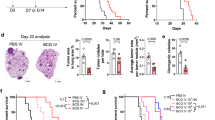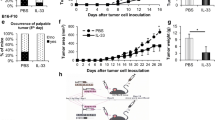Abstract
Direct tumor injections of CpG (ODN #1826) into murine tumors markedly suppressed the tumor growth and increased the survival of the mice. Tumor growth was reduced by 60–67% in Colon Tumor 26 (CT-26) and B-16 melanoma tumors treated with CpG as compared to untreated one. In CT-26 and B-16 tumors treated with CpG, the average survival of the animals were prolonged to 26 and 28 d as compared to 16 and 18 d in control respectively. Long-term surviving animals in CT-26 tumor groups were also protected from a subsequent injection of a lethal dose of tumor cells. In the present study, effect of CpG was mediated through CD8+ T cells, as their depletion resulted in the abrogation of the therapeutic effects of the CpG. It suggests that direct tumor injection might be a simple means of achieving a clinical response in cancer patients.
Similar content being viewed by others
References
Ballas ZK, Krieg AM, Warren T, Rasmussen W, Davix HL, Waldschmidt M, Weiner GJ (2001) Divergent therapeutic and immunologic effects of oligodeoxynucleotides with distinct CpG motifs. J. Immunol. 167: 4878–4886.
Brooks SP, Karakousis CP, Takita H, Sharma S (2002) Regression of murine tumors following direct tumor injection of biological response modifiers (BRM). In: Proceedings of the American Association for Cancer Research, 93rd Annual Meeting, April 6–10, San Francisco, p. 43, ISSN 0197–016X.
Brooks SP, Takita H, Fang Y, Vaughan M, Sharma SM, Karakousis CP (2002) Intra-tumoral injection of GM-CSF in perspective. J. Med. (accepted).
Carpentier AF, Chen L, Maltoni F, Delattre JY (1999) Oligodeoxynucleotides containing CpG motifs can induce rejection of a neuroblastoma in mice. Cancer Res. 59: 5429–5432.
Carpentier AF, Xie J, Mokhtari K, Delattre JY (2000) Successful treatment of intracranial gliomas by oligodeoxynucleotides containing CpG motifs. Clin. Cancer Res. 6: 2469–2473.
Davila E, Celis E (2000) Repeated administration of Cytosine-Phosphorothiolated Guanine containing oligonucleotides together with peptide/protein immunization results in enhanced CTL responses with anti-tumor activity. J. Immunol. 165: 539–547.
Egilmez NK, Jong YS, Sabel MS, Jacob JS, Mathiowitz E, Bankert RB (2000) In situ tumor vaccination with interleukin-12 encapsulated biodegradable microspheres: induction of tumor regression and potent antitumor immunity. Cancer Res. 60: 3832–3837.
Gurunathan S, Klinman DM, Seder RA (2000) DNA vaccines: immunolgy, applications and optimization. Annu. Rev. Immunol. 18: 927–974.
Hartmann G, Weiner GJ, Krieg AM (1999) CpG DNA: a potent signal for growth, activation and maturation of human dendritic cells. Proc. Natl. Acad. Sci. 96: 9305–9310.
Kawarada Y, Ganss R, Garbi N, Sacher T, Arnold B, Hammerling J (2001) Nk? and CD8+ T cell mediated eradication of established tumors by peritumoral injection of CpG containing oligodeoxynucleotides. J. Immunol. 167: 5247–5253.
Liu HM, Newbrough SE, Bhatia SK, Dahle CE, Krieg AM, Weiner GJ (1998) Immunostimulatory CpG oligodeoxynucleotides enhance the immune response to vaccine strategies involving granulocyte-macrophage colony-stimulatory factor. Blood 92: 3730–3736.
McCluskie MJ, Weeratna RD, Davis HL (2000) The role of CpG in DNA vaccines. Springer Semin. Immunopathol. 22: 125–132.
Verthelyi D, Ishii KJ, Gursel M, Takeshita F, Klinman DM (2001) Human peripheral blood cells differentially recognize and respond to two different CpG motifs. J. Immunol. 166: 2372–2377.
Weeratna RD, McCluskie MJ, Xu Y, Davis HL (2000) CpG DNA induces stronger immune responses with less toxicity than other adjuvants. Vaccine 18: 1755–1762.
Weiner GJ (2000) The immunobiology and clinical potential of immunostimulatory CpG oligodeoxynucleotides. J. Leukoc. Biol. 68: 455–463.
Wooldridge JE, Ballas Z, Krieg AM, Weiner GJ (1997) Immunostimulatory oligodeoxynucleotides containing the CpG motif enhances the efficacy of monoclonal antibody therapy of lymphoma. Blood 89: 2994–2998.
Author information
Authors and Affiliations
Corresponding author
Rights and permissions
About this article
Cite this article
Sharma, S., Karakousis, C.P., Takita, H. et al. Intra-tumoral injection of CpG results in the inhibition of tumor growth in murine Colon-26 and B-16 tumors. Biotechnology Letters 25, 149–153 (2003). https://doi.org/10.1023/A:1021927621813
Issue Date:
DOI: https://doi.org/10.1023/A:1021927621813




